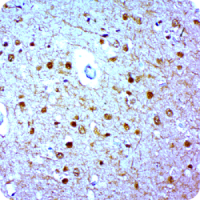
The GeneBio Neurofilament Antibody (Clone 2F11) is a highly specific mouse monoclonal antibody developed for the detection of neurofilament proteins, the major structural components of the neuronal cytoskeleton. Neurofilaments are intermediate filaments that maintain axonal caliber, regulate conduction velocity, and serve as critical biomarkers for neuronal integrity and axonal pathology. Clone 2F11 recognizes a conserved epitope present in multiple neurofilament subunits, enabling reliable detection of neurons and their processes in both central and peripheral nervous system tissues. It is widely validated for immunohistochemistry (IHC) on formalin-fixed paraffin-embedded (FFPE) tissues, immunocytochemistry (ICC), Western blotting (WB), and frozen tissue sections, delivering robust staining with strong specificity and minimal background. In IHC, 2F11 produces intense labeling of neuronal cell bodies and axons, making it particularly valuable in neuropathology studies, including investigations of neurodegenerative diseases, traumatic brain injury, and peripheral neuropathies. With its proven performance, the Neurofilament 2F11 antibody is frequently used in diagnostic and research settings to highlight neuronal architecture, evaluate axonal damage, and support studies in developmental neurobiology. The GeneBio Neurofilament Antibody (Clone 2F11) is protein A purified, formulated in PBS with BSA, glycerol, and sodium azide for enhanced stability, and supplied at ~1 mg/mL concentration. It is shipped chilled and recommended for storage at –20 °C, avoiding repeated freeze–thaw cycles. With superior specificity, reproducibility, and versatile application utility, the GeneBio Neurofilament Antibody (2F11) is an essential reagent for neuroscientists and pathologists studying neuronal structure, function, and pathology.
Mouse
2F11
Buffer with protein carrier and preservative
IgG1, Kappa
Human, Rabbit, Cat, Mouse and Rat. Does not react with dog.
Brain
Human NF-H isolated brain cells
This antibody stains neurons (axons) of the central and peripheral nervous system. It is useful for the identification of tumors with neuronal differentiation viz. Neuroblastomas, Ganglioneuromas, Pheochromocytomas and Esthesioblastomas.